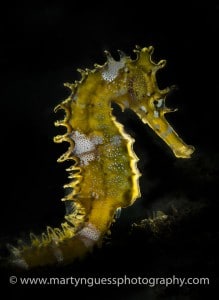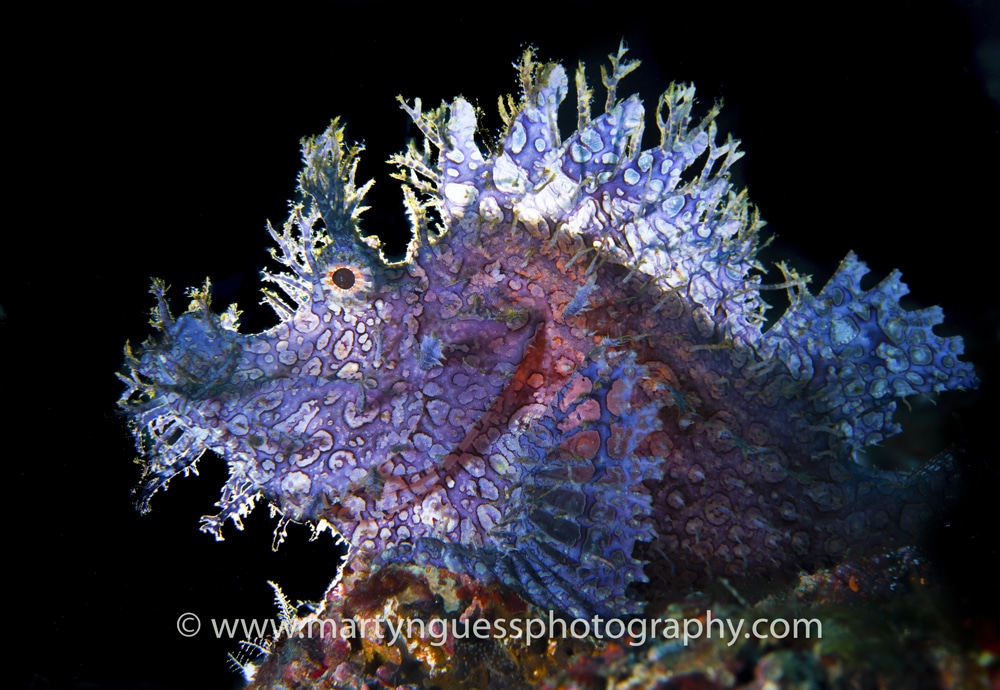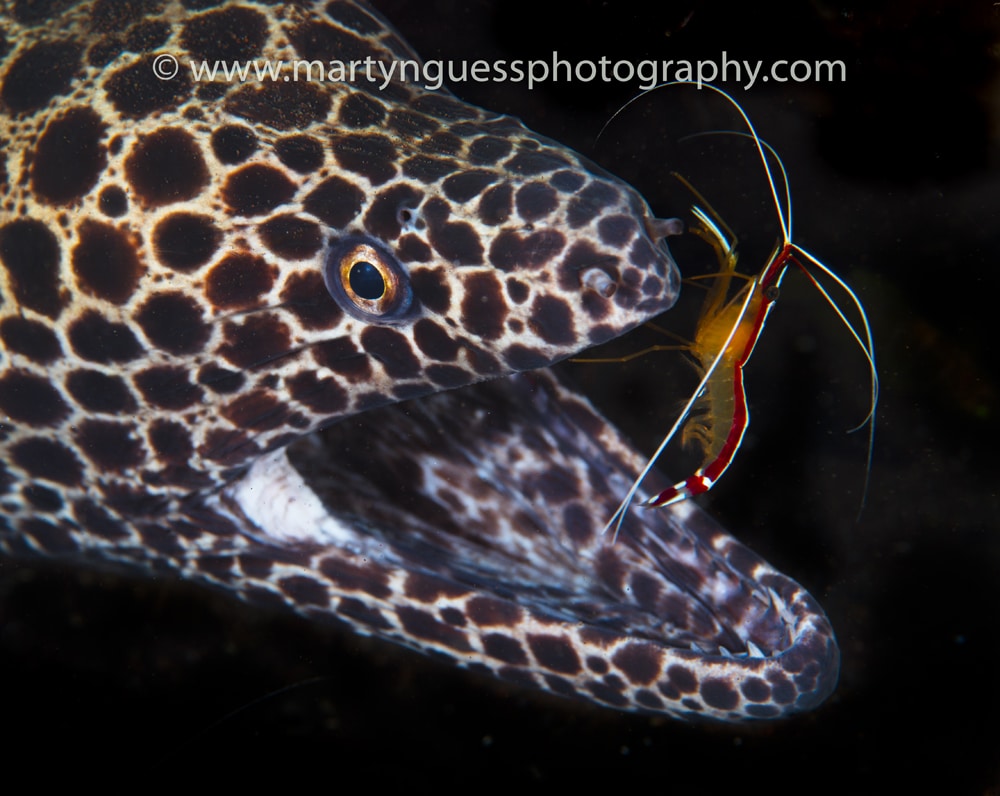News
Scubaverse Underwater Photographer Interview: Martyn Guess

In an ongoing series, Scubaverse’s Underwater Photography Editors Nick and Caroline Robertson-Brown talk to underwater photographers from around the world that they admire. In this blog: Martyn Guess…
My diving career started in the late 1970’s when a family friend took me underwater in southern Spain. An interesting experience given that he managed to knock my mask off with his fins on the first dive! I was amazed by the colours and fish life and very keen to pursue the sport, although it wasn’t until quite a few years later that I went through the formal training process, together with my eldest son, and we both qualified on his 12th Birthday at Stoney Cove in the UK.
Since then, and over the last 22 years, I have dived all over the world and visited some amazing places and seen some wonderful things.
I have travelled extensively through Indonesia and the Philippines and have managed to build up an extensive portfolio of weird and wonderful creatures which I primarily post on Instagram.
I have had a fair amount of success with national and international competitions and I am now passing on some of my knowledge as I teach underwater photography, primarily by running photographic workshops with Scuba Travel, but I also do some one to one courses in the UK. We are going to the Azores in September with a group following a research trip there last summer and also Anilao, Philippines in May and Bali in October. I am keen to take photographers to the best places and some new destinations. I have recently become Chairman of Photosub – the Surrey based group of underwater photographers started by the late Len Deely; we have some very talented people in the club.
N&C: How did your underwater photography start?
MG: A couple of years after I qualified in 1995 I went on holiday to Grand Cayman and found myself diving with Cathy Church, who with her husband Jim wrote the definitive book on the Nikonas V film camera for underwater use. I had been a keen land photographer since college days and was fascinated by some of the images in her shop, so it only took a day or two before I signed up for a course with her. I have to say I was immediately smitten and on the slippery slope!
When I got back home I went to see Alan James in Bristol and bought the same camera. For those that don’t know the Nikonas it was a great little camera but focus was achieved by guesswork and setting the F stop to an open aperture giving you infinity, or little prongs that stuck out from the lens for macro and close up use when a smaller aperture was selected. The idea being to get the subject between the prongs – no mean feat! You were also limited to 36 exposures with no real idea of how the images would look until the film had been processed. However, despite all of this I was hooked and used the Nikonas for quite a few years until digital cameras started to come onto the market.
N&C: What is your favourite u/w camera equipment (past & present) & why?
MG: I currently use a Nikon D5 which is a truly amazing camera. One of my favourite tools to use with the camera is the Retra LED Snoot which only allows a small amount of light from the strobe to hit the subject. You can isolate subjects from the background and where the subject is on a mucky bottom or distracting background this can be really useful in creating images that leap off the page. They are easier to use than people think and I teach the techniques on my workshops. It is always rewarding to see people reap the benefits of this type of lighting.
The Retra is so much better and easier to use than the old snoots that I had to make from plumbing parts, as the strobe modelling light shines through the snoot and is magnified so that it can be easily aimed. When I first started snoot lighting most of my images were totally black as it was pure guesswork where the light would land and often I had to nab my wife Sue to hold the bits of pipes over the subject!
N&C: What would be your advice to anyone new to underwater photography?
MG: I recommend going on a one to one course with an expert if you can afford it. This will cut out a lot of wasted time trying to work it out on your own. There is a lot to take on board such as equipment choice, lighting, angle of view, getting in the best position, camera settings etc and a course will put you on the right path. It’s exactly what I did years ago and my photography came on leaps and bounds as a result.
Get to know your camera and other equipment. Try and understand the settings and what they do. If this becomes second nature on land it will be so much easier underwater. Many people come to underwater photography without any knowledge of what the various camera settings really do and how they work together. Any good course will normally start with making sure that there is a good understanding of the basics of using the various settings together to achieve a good result.
Read the books written by the experts such as Alex Mustard or Martin Edge. Take your time and make sure you understand what you are reading. These guys take great images and in their books, they tell how they do it! Join a regional underwater photography club and BSOUP. There is a fountain of knowledge out there and in my experience members are very happy to help and offer advice to people starting out. All have regular meetings where there are useful presentations and the opportunity to enter competitions so that you can gauge how you are doing.
Consider going on a specific photography dive trip. There are quite a few of us leading these trips now. You will learn so much in the field and with help on hand above and under the water. I get students who can’t believe how much they learn in a week or two. They come home with portfolios of images that they never thought they would achieve.
Make sure that your diving skills are up to scratch. You are a diver first and a photographer second! Excellent buoyancy is a prerequisite if you are going to manoeuvre yourself into a good position to take a photograph without crashing into the reef or the bottom.
Above all else don’t get disheartened. Practice, Practice and Practice and the results will start to get better.
N&C: What, or who, has been your single biggest inspiration for your underwater photography?
MG: I would say without a doubt my friends Martin Edge and Alex Mustard. I have been on so many trips with both of them that sooner or later something had to rub off on me! I would look at their images and then determine that I was going to somehow take them myself. Nowadays, their inspiration and the many excellent photographers there are around the world drives me to try new techniques and to constantly perfect my image making.
N&C: What image are you most proud of and why?
MG: There is no specific image but I am proud of my recent back lit and snooted macro subjects such as Thorny Sea horses and Weedy Rhinopias. They are tough to light but the results can be spectacular. Also I have been into shark photography for the last couple of years and am very pleased with some dusk shots with Great Hammerheads and also open ocean Blue Sharks in the Azores. Sharks are amazing but you have to put yourself in the right position at the right time to get good images and be prepared to get very close!
N&C: Where is your favourite dive location, and is it for the photography?
MG: I would have to say Raja Ampat and definitely for photography. This is primarily due to the health of the corals and sea life. There is such a huge amount to photograph and if you are there when the bait fish shoals are around, the sight of them and all of the predators circling combined with the coral and the colours is simply breathtaking.
N&C: What are you views on marine life manipulation, moving subjects?
MG: Quite simply – dive and look, but don’t touch or harass anything! I teach on my workshops that if a subject is in the wrong place or facing the wrong way then move on. There will be another better opportunity as the dive progresses. From my experience people get blinkered by the guide spotting something maybe quite rare and in their eagerness to get a shot of this rare critter they snap away and don’t really think whether it is in a good position or whether the image they create will be a keeper. When they review their images in camera, and realise that perhaps the subject is not in a good position, some people can perhaps be tempted to try and get a better image by moving the critter. Maybe they have seen, as we all have, a guide (who is only seeking to please his client) move a subject and think this is quite acceptable behaviour. It might have been more prevalent in the past but is definitely a no-go area now. Sea life and the marine environment is so fragile that we all have to do what we can to help protect it and ensure that there is something left for future generations.
N&C: What do you look for when you are making your images?
MG: I am always trying to create an image which is not simply a record shot of the subject and often a different perspective, be it lighting, camera blur, lens bokeh or angle of view. There are so many great photographers out there that I am always striving to not only come up with something different but to perfect the shot as best I can. I am a stickler for the detail and getting the composition, lighting and focus right. I go through phases with a specific technique and will hammer this until I get what I want. The subject doesn’t need to be something exotic, it can be a common subject but maybe photographed in a different way, so I concentrate on looking for something which is in a good position and which will enable me to do what I want to do creatively.
N&C: What motivates you to take u/w photos?
MG: It’s my ability to record the underwater world that drives me. I am fascinated by the fact that new species are being discovered in the World’s oceans every year. I remember seeing a coffee table book years ago with a pygmy seahorse on the cover. I had never seen one and didn’t even know they existed. Without that photograph, I wouldn’t have been driven to find out where it was taken and to go there myself and then to be able to show other people what fascinating creatures live under the surface.
N&C: If you could photograph any one thing/place what or where would that be?
MG: I have quite a few things on my bucket list. Top of this is any of the great Whales. One day I hope to get to somewhere I can do that. I also want to photograph Great Whites!
To find out more about Martyn’s underwater photography trips with Scuba Travel click here.
Gear News
Introducing the TR-80, IR-50 and CS-30 Regulators from DYNAMICNORD

Whether you are a beginner or a professional diver – with the three new main regulators from DYNAMICNORD, everyone will find their favourite regulator. They all look super stylish.
Excellent performance with the TR-80
Quality and performance are the be-all and end-all for regulators. It is not for nothing that the TR stands for Tec Reg. The innovative design of the TR-80 guarantees absolute reliability – even in ice-cold waters.

Perfect breathing effort at 0.8 J/l / certified for diving in waters below 10 degrees / structural design made of solid brass for best cold protection / membrane-compensated design with dry seal of the first stage / reduced exhalation effort thanks to optimized exhalation membrane and bubble deflector / adjustable Venturi (dive/predive) and adjustment knob for individual inhalation comfort / innovative design of the front cover prevents free-flow in strong currents or when diving with scooters / design made of sandblasted brass, matt chrome finish / 2 HP and 4 LP outlets / mouthpiece made of high-quality, anti-allergic silicone for maximum comfort.


Amazing underwater adventures with the IR-50
The IR-50 is the top regulator for advanced and experienced divers. Natural breathing is the essence of this regulator.

Ideal breathing effort at 0.8 J/l /certified for diving in waters below 10 degrees / compensated membrane / adjustable venturi (dive/predive) and adjustment knob for individual inhalation comfort/ outlet valve and deflector for minimum exhalation effort and reduction of bubbles on the face / design made of sandblasted brass, matt chrome finish / 2 HP and 4 NP outlets / mouthpiece made of high-quality, anti-allergic silicone for maximum comfort.


The Workhorse – our CS-30
For diving centres and diving beginners – the workhorse stands for strong construction, reliability and robustness. Perfect for your training.

Optimal breathing effort at 0.8 J/l /recommended for diving in waters above 10 degrees / non-compensated piston / adjustable venturi (dive/predive) / outlet valve and deflector for minimum exhalation effort and reduction of bubbles on the face / design made of sandblasted brass, matt chrome finish / 1 HP and 3 NP outlets / mouthpiece made of high-quality, anti-allergic silicone for maximum comfort.


Octopus OP-30
The OP-30 is the ideal addition to all DYNAMICNORD regulators. It is identical in construction to the CS-30.

The TR-80, IR-50, CS-30 (DIN & INT) regulators and the Octopus OP-30 are available from DYNAMICNORD dealers and in the online store.
DYNAMICNORD – Your Outdoor Companion.
Marine Life & Conservation
Paul Watson Released as Denmark Blocks Japan’s Extradition Bid

Renowned anti-whaling activist Paul Watson has been released from custody in Greenland after spending five months in detention. Denmark’s Justice Ministry rejected Japan’s request for his extradition, citing insufficient guarantees that his time already served in custody would be credited against any potential sentence.
The 74-year-old Canadian-American was arrested on July 21 in Nuuk, Greenland’s capital, when his ship docked to refuel. His arrest was based on a 2012 Japanese warrant related to a 2010 encounter in Antarctic waters. Japan alleged Watson obstructed operations and caused damage to a whaling research ship during efforts to disrupt illegal whaling. Watson has consistently denied these claims, maintaining his commitment to marine conservation.
Denmark, which oversees extradition matters for Greenland, concluded that while the legal conditions for extradition were met, the lack of assurances from Japan regarding time-served credit made extradition untenable.
In a video shared by his foundation, Watson expressed gratitude and relief, saying, “After five months, it’s good to be out… and good to know they’re not sending me to Japan.” He added that the most difficult part of his time in custody was being separated from his two young sons.
Watson is a pioneering figure in marine conservation, known for founding the Captain Paul Watson Foundation in 2022 after decades of activism with the Sea Shepherd Conservation Society. His bold efforts to defend marine life have earned him widespread support, including from celebrities and conservationists. His work has also been featured in the acclaimed reality TV series Whale Wars.
Watson’s lawyer, Jonas Christoffersen, praised the decision, stating, “We are happy and relieved that Paul Watson is now free.” He added that Watson is eager to reunite with his family and continue his vital work.
The arrest occurred while Watson’s vessel, the M/Y John Paul DeJoria, was en route to the North Pacific with a team of 26 volunteers to intercept a Japanese whaling ship. His foundation described the arrest as politically motivated and emphasized that Watson’s actions were focused on ending illegal whaling practices.
Japan resumed commercial whaling in 2019 after leaving the International Whaling Commission, asserting that whale meat is a cultural tradition. Conservationists, however, continue to challenge these practices, highlighting their impact on marine ecosystems.
Despite the challenges, Watson remains steadfast in his mission to protect marine life and bring attention to whaling practices. His dedication to ocean conservation has made him a globally respected advocate for the environment.
-

 News2 months ago
News2 months agoIconic SS United States to become the World’s Largest Artificial Reef
-

 News3 months ago
News3 months agoBook Review – 52 Assignments: Underwater Photography
-

 Gear News3 months ago
Gear News3 months agoDYNAMICNORD – New German diving brand enters the British market
-

 News3 months ago
News3 months agoExploring Cenote El Pit: A Diver’s Dream
-

 Gear News3 months ago
Gear News3 months agoTry BARE drysuits (and maybe even win one!) this Friday with Sea & Sea at North West Dive Fest
-

 Marine Life & Conservation3 months ago
Marine Life & Conservation3 months agoBook Review: Coral Triangle Cameos
-

 Blogs2 months ago
Blogs2 months agoDive the Egyptian Red Sea this Autumn with Regaldive
-

 News3 months ago
News3 months ago2024 Ocean Art Underwater Photo Competition Announced




















